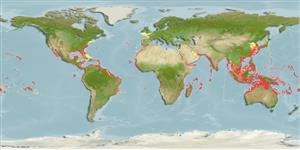>
Tetraodontiformes (Puffers and filefishes) >
Diodontidae (Porcupinefishes (burrfishes))
Etymology: Chilomycterus: Greek, cheilos = lip + Greek, mykter, -eros = nose (Ref. 45335).
More on author: Linnaeus.
Environment: milieu / climate zone / Tiefenbereich / distribution range
Ökologie
seewasser riff-verbunden; tiefenbereich 20 - 100 m (Ref. 9680). Subtropical; - 24°S, 98°W - 34°W
Circumglobal: Gulf of Mexico, Atlantic, Indian and Pacific oceans.
Size / Gewicht / Alter
Geschlechtsreife: Lm ? range ? - ? cm
Max length : 69.7 cm NG Männchen/unbestimmt; (Ref. 89467); common length : 30.0 cm TL Männchen/unbestimmt; (Ref. 26999)
Rückenflossenstacheln (insgesamt) : 0; Rückenflossenweichstrahlen (insgesamt) : 12 - 14; Afterflossenstacheln: 0; Afterflossenweichstrahlen: 11 - 14. Adults grey to brown with a black gular band and small black spots on upper surfaces and fins; pelagic juveniles blue with dark spots above, the spots descending to belly (Ref. 4423).
Body shape (shape guide): short and / or deep.
Adults found in reefs and over soft bottoms to depths of 100 m, but may occur deeper in the tropics (Ref. 30573). Often found washed up on beaches. Known to brace themselves against the substrate to sleep at night (Ref. 4930). Appear to be active during the day. Juveniles often with floating weeds (Ref. 48637). Solitary. Juveniles pelagic in oceanic surface waters (Ref. 30573). Feed on hard-shelled invertebrates. Not usually marketed.
Life cycle and mating behavior
Geschlechtsreife | Fortpflanzung | Ablaichen | Eier | Fecundity | Larven
Leis, J.M., 2001. Diodontidae. Porcupine fishes (burrfishes). p. 3958-3965. In K.E. Carpenter and V. Niem (eds.) FAO species identification guide for fishery purposes. The living marine resources of the Western Central Pacific. Vol. 6. Bony fishes part 4 (Labridae to Latimeriidae), estuarine crocodiles. FAO, Rome. (Ref. 9680)
IUCN Rote Liste Status (Ref. 130435: Version 2025-1)
Bedrohung für Menschen
Venomous
Nutzung durch Menschen
Fischereien: nicht kommerziell
Tools
Zusatzinformationen
Download XML
Internet Quellen
Estimates based on models
Preferred temperature (Ref.
123201): 18.4 - 28.3, mean 27 °C (based on 959 cells).
Phylogenetic diversity index (Ref.
82804): PD
50 = 0.5156 [Uniqueness, from 0.5 = low to 2.0 = high].
Bayesian length-weight: a=0.04677 (0.01905 - 0.11483), b=2.82 (2.61 - 3.03), in cm total length, based on LWR estimates for this (Sub)family-body shape (Ref.
93245).
Trophic level (Ref.
69278): 3.5 ±0.41 se; based on food items.
Widerstandsfähigkeit (Ref.
120179): hoch, Verdopplung der Population dauert weniger als 15 Monate. (Preliminary K or Fecundity.).
Fishing Vulnerability (Ref.
59153): Low vulnerability (20 of 100).
🛈
Nutrients (Ref.
124155): Calcium = 18 [7, 59] mg/100g; Iron = 0.558 [0.274, 1.366] mg/100g; Protein = 19.2 [17.0, 21.4] %; Omega3 = 0.166 [0.086, 0.318] g/100g; Selenium = 25.4 [10.8, 56.7] μg/100g; VitaminA = 17.8 [4.5, 80.2] μg/100g; Zinc = 0.572 [0.367, 0.913] mg/100g (wet weight);
